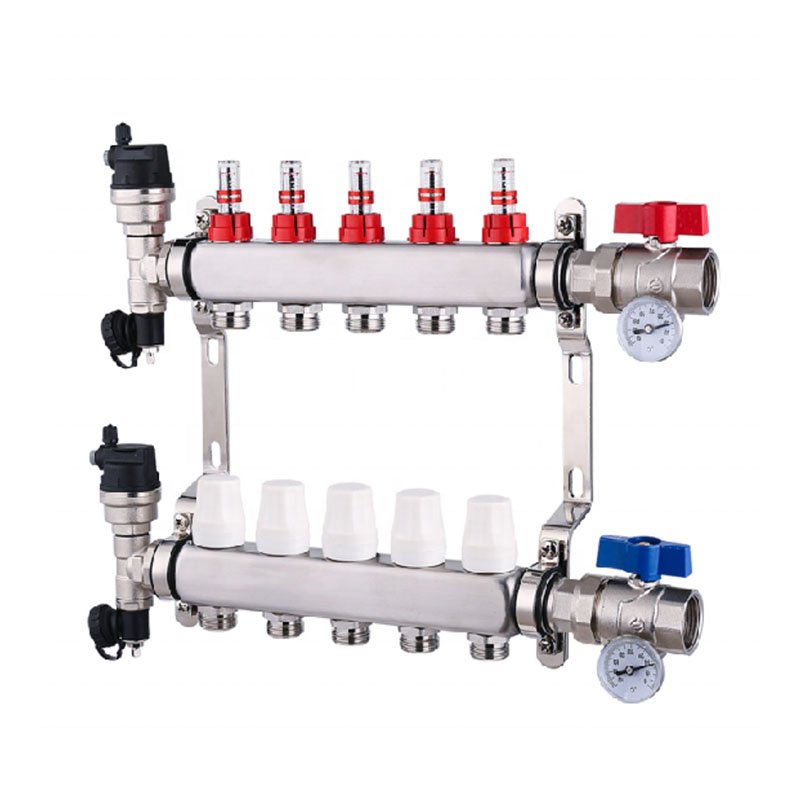Installing a radiant heat manifold upside down might not seem like a big issue, but it can cause a range of performance problems that can lead to inefficient heating and expensive repairs. Incorrect installation may disrupt water flow, damage valves, or even cause long-term system failures. How can you ensure that your radiant heat manifold is installed correctly to avoid these issues? Keep reading to learn more about the potential risks and best practices for installing radiant heat manifolds.
Installing a radiant heat manifold upside down can lead to poor system performance, uneven heating, and damage to the system components. Ensuring the manifold is installed correctly is crucial for efficient water flow and reliable performance.
Now that you understand the risks of incorrect installation, let’s dive deeper into how you can avoid these issues and ensure that your radiant heat manifold is properly placed for optimal performance.

What is an UFH manifold?
An underfloor heating (UFH) manifold is a key component in distributing warm water to the different circuits of an underfloor heating system. It functions as a distribution point where hot water from the boiler or heating pump is split into multiple loops that are embedded in the floor. Each loop is connected to a separate zone of the house, allowing for precise control of the temperature in different areas.
The manifold is designed to be durable and reliable, usually made from materials such as brass or stainless steel. It typically includes flow meters, isolation valves, and air vents, making it easy to manage the flow of water and maintain the system over time. When installing the manifold, it’s important to ensure that it is mounted correctly and securely, as incorrect placement or orientation can affect the performance of the entire system.
Manifolds are available in different sizes and configurations, depending on the heating needs of the building. The number of outlets (or ports) on the manifold determines how many circuits the system can handle. For larger homes or commercial spaces, a manifold with more outlets may be required to ensure efficient heating throughout the property.
How many manifolds for underfloor heating?
The number of manifolds required for underfloor heating depends on the size of the building and the complexity of the heating system. In smaller homes, a single manifold might suffice to distribute hot water to all the underfloor heating loops. However, larger buildings or multi-story homes might require multiple manifolds to ensure an even and efficient distribution of heat across all zones.
A standard underfloor heating manifold typically has 6 to 12 outlets, but some larger systems may need manifolds with even more outlets. The key factor in determining the number of manifolds is the total number of heating loops needed to cover the entire floor area. Each manifold will need to handle the flow rate and pressure required to effectively heat each loop, which means larger systems may require additional manifolds to prevent any pressure loss or flow imbalance.
It’s also important to consider the type of floor and the heating design, as this can influence the number of manifolds needed. For example, a system with multiple zones or rooms will likely require a manifold for each zone to maintain control over the temperature in each area. When planning an underfloor heating system, it’s essential to work with an expert to ensure you select the right number of manifolds for the project.
Where are the underfloor heating manifolds located?
The location of the underfloor heating manifold is critical for ensuring efficient system performance and ease of maintenance. Typically, the manifold is installed in a central, accessible location, such as a utility room, cupboard, or basement. This ensures that the manifold is close to the heating source, such as the boiler or pump, which helps maintain proper water pressure and flow rate.
The manifold should also be installed in a place that is easy to reach for regular maintenance, such as bleeding air from the system, adjusting flow rates, or troubleshooting any issues. Ideally, the manifold should be placed at a height of around 300 mm to 500 mm from the floor to make it easy to operate. It’s also important to keep the manifold away from damp or high-moisture areas that could cause corrosion or damage over time.
In multi-story homes or large buildings, it’s often necessary to install additional manifolds on different levels of the property. These manifolds should be positioned centrally within each floor to ensure even distribution of hot water to all zones. By planning the location of the manifolds carefully, you can avoid issues with pressure loss or uneven heating in certain areas of the building.
What is the difference between a manifold and an actuator?
A manifold and an actuator are both essential components in an underfloor heating system, but they serve different functions. A manifold is responsible for distributing hot water to the various loops or circuits in the system. It acts as a central distribution point, ensuring that water is delivered to each zone at the correct pressure and flow rate.
On the other hand, an actuator is a device that controls the flow of water to individual zones by opening or closing valves. Actuators are often connected to thermostats or temperature sensors, allowing them to regulate the temperature in each zone. When a thermostat detects that a room has reached its desired temperature, the actuator closes the valve to stop the flow of hot water to that particular loop.
While the manifold distributes water, the actuator helps control how much water flows into each circuit. The two components work together to ensure efficient and effective heating, but they operate independently of each other. The manifold needs to be installed in the correct position, while the actuators should be connected to the manifold in a way that allows them to control the temperature of each zone.

Where is the best position for underfloor heating thermostat?
The best position for an underfloor heating thermostat is typically in a central area of the room, away from heat sources like radiators, windows, and direct sunlight. Placing the thermostat in a central location ensures that it can accurately measure the room’s temperature, providing better control over the heating system.
It’s also important to avoid installing the thermostat on an exterior wall, as this could result in inaccurate readings due to temperature fluctuations. Ideally, the thermostat should be mounted about 1.5 meters above the floor to ensure it detects the air temperature at a standard height, which is where people will generally feel the most comfortable.
In larger spaces or multi-zone systems, each room or zone should have its own thermostat to allow for independent control of temperature. This enables you to adjust the temperature in different areas of the house, optimizing comfort and energy efficiency. By strategically placing thermostats in the right locations, you can ensure that your underfloor heating system operates efficiently and delivers consistent warmth.
Should underfloor heating insulation be above or below the slab?
When installing underfloor heating, the insulation layer should be placed below the heating pipes and above the slab. This helps to maximize the efficiency of the system by preventing heat from escaping downwards into the ground. Insulation beneath the slab ensures that most of the heat generated by the system is directed upwards into the room, where it is needed most.
Placing insulation below the slab also prevents heat loss into the subfloor, which can reduce the overall efficiency of the system. It helps to maintain the temperature within the room and prevents excessive energy consumption. In some cases, insulation may also be placed on top of the slab, but the most common and effective method is to place it underneath the heating pipes.
Proper insulation is key to ensuring that the underfloor heating system operates efficiently, reducing energy costs and improving overall comfort. Whether you are installing underfloor heating in a new build or retrofitting an existing space, it’s crucial to use high-quality insulation materials that can effectively retain heat and optimize the performance of the system.
Summary
Installing an underfloor heating manifold correctly is essential to ensuring efficient heating and long-term system performance. Pay attention to the placement, orientation, and integration of components like actuators and thermostats to optimize energy usage and avoid common installation errors. With careful planning, your radiant heat system will run smoothly, providing reliable and even warmth throughout your building.
Choose IVALVECRAFT, choose reliable partner, enjoy the high quality and best service.


